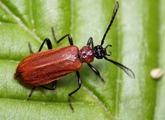Підтримуємо Вільну Україну
 We Support Free Ukraine
We Support Free Ukraine

Biodiversity Map
Taxa

Schizotus — subordinate taxa:
Taxon count: 1
-
Arthropodaphylum
Click to switch
to select orders
and filters > -
Hexapodasubphylum
Click to switch
to select orders
and filters > -
Insectaclass
Click to switch
to select orders
and filters > -
Coleopteraorder
Click to set
as the main taxon
and as a base
← of the left panel > -
Polyphagasuborder
Click to set
as the main taxon
and as a base
← of the left panel > -
Cucujiformiaseries
Click to set
as the main taxon
and as a base
← of the left panel > -
Tenebrionoideasuperfamily
Click to set
as the main taxon
and as a base
← of the left panel > -
Pyrochroidaefamily
Click to set
as the main taxon
and as a base
← of the left panel > -
Pyrochroinaesubfamily
Click to set
as the main taxon
and as a base
← of the left panel > -
Schizotusgenus
Click to set
as the main taxon
and as a base
← of the left panel >
PL
YES
name status: synonym
BioMap ID: 1021879
taxonomy checked: YES
valid name: Schizotus pectinicornis
Data on distribution in Poland

Statistics
- Records: 355
- Publications: 78
- Collections: 13
- Publication authors: 65
- Illustrations (iconography): 1
- Photos (specimen/observation): 7
Taxon description
Gatunek rozpowszechniony w niemal całej Europie, w Fennoskandii sięgający daleko poza koło podbiegunowe, a w południowej części kontynentu występujący głównie na terenach górzystych. W Polsce chrząszcz pospolity, ale stosunkowo rzadko notowany. Larwy żerują w martwych drzewach liściastych, rzadziej iglastych, pod zmurszałą korą gałęzi, pni i pniaków. Przepoczwarczenie następuje w drugiej połowie kwietnia lub w maju. Postacie dojrzałe pojawiają się w maju i czerwcu. Poławiano je zwykle na stanowiskach lęgowych.
Illustrations
... browse
 Schizotus
Schizotuspectinicornis
Photos
... browse
 Schizotus
Schizotuspectinicornis
 Schizotus
Schizotuspectinicornis
 Schizotus
Schizotuspectinicornis
 Schizotus
Schizotuspectinicornis
 Schizotus
Schizotuspectinicornis
 Schizotus
Schizotuspectinicornis
 Schizotus
Schizotuspectinicornis
External data sources
- Ostatnie rekordy
-
1140771
 ⊡
⊡ Pyrochroidae: Schizotus pectinicornis, PL, Pojezierze Pomorskie, ad Tuchola, UTM XV94, 1998 (Gutowski et al. 2005a)
Pyrochroidae: Schizotus pectinicornis, PL, Pojezierze Pomorskie, ad Tuchola, UTM XV94, 1998 (Gutowski et al. 2005a) -
1140770
 ⊡
⊡ Pyrochroidae: Schizotus pectinicornis, PL, Pojezierze Pomorskie, Pojezierze Południowopomorskie, Równina Charzykowska, P.N. Borów Tucholskich, pomorskie, Chojnice, Chojnice w., ad Bachorze, UTM XV66, 1998 (Gutowski et al. 2005a)
Pyrochroidae: Schizotus pectinicornis, PL, Pojezierze Pomorskie, Pojezierze Południowopomorskie, Równina Charzykowska, P.N. Borów Tucholskich, pomorskie, Chojnice, Chojnice w., ad Bachorze, UTM XV66, 1998 (Gutowski et al. 2005a) -
1140769
 ⊡
⊡ Pyrochroidae: Schizotus pectinicornis, PL, Pojezierze Pomorskie, Pojezierze Południowopomorskie, Bory Tucholskie, nadl. Osie, Wdecki P.K., kujawsko-pomorskie, Świecie, Osie, ad Osie, UTM CE24, 1998 (Gutowski et al. 2005a)
Pyrochroidae: Schizotus pectinicornis, PL, Pojezierze Pomorskie, Pojezierze Południowopomorskie, Bory Tucholskie, nadl. Osie, Wdecki P.K., kujawsko-pomorskie, Świecie, Osie, ad Osie, UTM CE24, 1998 (Gutowski et al. 2005a) -
1140768
 ⊡
⊡ Pyrochroidae: Schizotus pectinicornis, PL, Pojezierze Pomorskie, Pojezierze Południowopomorskie, Bory Tucholskie, Zaborski P.K., pomorskie, Chojnice, Brusy, ad Laska, UTM XV67, 1998 (Gutowski et al. 2005a)
Pyrochroidae: Schizotus pectinicornis, PL, Pojezierze Pomorskie, Pojezierze Południowopomorskie, Bory Tucholskie, Zaborski P.K., pomorskie, Chojnice, Brusy, ad Laska, UTM XV67, 1998 (Gutowski et al. 2005a) -
1140767
 ○
○ Pyrochroidae: Schizotus pectinicornis, PL, Bory Tucholskie, Pojezierze Pomorskie, UTM XV86 (Gutowski et al. 2005a)
Pyrochroidae: Schizotus pectinicornis, PL, Bory Tucholskie, Pojezierze Pomorskie, UTM XV86 (Gutowski et al. 2005a) -
1115817
 ⊡
⊡ Pyrochroidae: Schizotus pectinicornis, PL, Wyżyna Małopolska, Nizina Środkowomazowiecka, Równina Kozienicka, mazowieckie, Radom, Jedlińsk, Wielogóra, UTM EC10, 2020, leg. M. Miłkowski
Pyrochroidae: Schizotus pectinicornis, PL, Wyżyna Małopolska, Nizina Środkowomazowiecka, Równina Kozienicka, mazowieckie, Radom, Jedlińsk, Wielogóra, UTM EC10, 2020, leg. M. Miłkowski -
1115211
 ⊡
⊡ Pyrochroidae: Schizotus pectinicornis, PL, Wyżyna Małopolska, Wyżyna Lubelska, Małopolski Przełom Wisły, Andrzejów, mazowieckie, Zwoleń, Przyłęk, rez. Borowiec, rez. Borowiec, UTM EB58, 2019, leg. M. Miłkowski
Pyrochroidae: Schizotus pectinicornis, PL, Wyżyna Małopolska, Wyżyna Lubelska, Małopolski Przełom Wisły, Andrzejów, mazowieckie, Zwoleń, Przyłęk, rez. Borowiec, rez. Borowiec, UTM EB58, 2019, leg. M. Miłkowski -
1115186
 ⊡
⊡ Pyrochroidae: Schizotus pectinicornis, PL, Wyżyna Małopolska, Nizina Środkowomazowiecka, Równina Kozienicka, mazowieckie, Radom m., Radom, Radom-Wielogóra ad Radom, UTM EC10, 2019, leg. M. Miłkowski
Pyrochroidae: Schizotus pectinicornis, PL, Wyżyna Małopolska, Nizina Środkowomazowiecka, Równina Kozienicka, mazowieckie, Radom m., Radom, Radom-Wielogóra ad Radom, UTM EC10, 2019, leg. M. Miłkowski -
1115185
 ⊡
⊡ Pyrochroidae: Schizotus pectinicornis, PL, Wyżyna Małopolska, Nizina Południowomazowiecka, Równina Radomska, mazowieckie, Radom m., Radom, Radom-Borki, UTM EB09, 2019, leg. M. Miłkowski
Pyrochroidae: Schizotus pectinicornis, PL, Wyżyna Małopolska, Nizina Południowomazowiecka, Równina Radomska, mazowieckie, Radom m., Radom, Radom-Borki, UTM EB09, 2019, leg. M. Miłkowski -
1070168
 ×
× Pyrochroidae: Schizotus pectinicornis, PL, Puszcza Białowieska, podlaskie, 2013, leg. J. Ługowoj
Pyrochroidae: Schizotus pectinicornis, PL, Puszcza Białowieska, podlaskie, 2013, leg. J. Ługowoj - ... more
- Powiązane publikacje
-
Plewa R., Jaworski T., Hilszczański J., Horák J. 2017a. Investigating the biodiversity of the forest strata: The importance of vertical stratification to the activity and development of saproxylic beetles in managed temperate deciduous forests. For. Ecol. Manage., 402:186-193.
 Show records
Show records -
Kubisz D., Iwan D., Tykarski P. 2015. Tenebrionoidea: Mycetophagidae, Ciidae, Mordellidae, Zopheridae, Meloidae, Pyrochroidae, Salpingidae, Anthicidae. Critical checklist, distribution in Poland and meta-analysis. Coleoptera Poloniae, 3, University of Warsaw – Faculty of Biology, Natura optima dux Foundation, Warszawa.
 selected pages
selected pages Show records
Show records -
Plewa R., Jaworski T., Hilszczański J. 2014b. Martwe drewno a jakościowa i ilościowa struktura chrząszczy (Coleoptera) saproksylicznych w drzewostanach dębowych. Studia i Materiały CEPL w Rogowie, 41(4):279-299.
 Show records
Show records -
Rutkiewicz A., Borowski J., Byk A., Mokrzycki T. 2013. Waloryzacja lasów Leśnego Kompleksu Promocyjnego „Lasy Spalsko-Rogowskie” na podstawie zgrupowań chrząszczy saproksylicznych powierzchni pni drzew. Studia i Materiały CEPL w Rogowie, 2(35):129-159.
 Show records
Show records -
Mokrzycki T., Borowski J., Byk A., Rutkiewicz A. 2013. Waloryzacja ekosystemów Leśnego Kompleksu Promocyjnego „Lasy Spalsko-Rogowskie” na podstawie struktury zgrupowań chrząszczy (Coleoptera) zasiedlających pniaki. Studia i Materiały CEPL w Rogowie, 2(35):48-81.
 Show records
Show records - ... more






